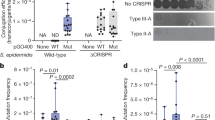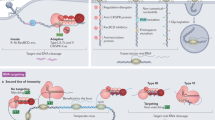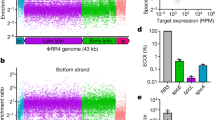Abstract
Arrays of clustered, regularly interspaced short palindromic repeats (CRISPRs) are widespread in the genomes of many bacteria and almost all archaea. These arrays are composed of direct repeats that are separated by similarly sized non-repetitive spacers. CRISPR arrays, together with a group of associated proteins, confer resistance to phages, possibly by an RNA-interference-like mechanism. This Progress discusses the structure and function of this newly recognized antiviral mechanism.
This is a preview of subscription content, access via your institution
Access options
Subscribe to this journal
Receive 12 print issues and online access
$209.00 per year
only $17.42 per issue
Buy this article
- Purchase on Springer Link
- Instant access to full article PDF
Prices may be subject to local taxes which are calculated during checkout


Similar content being viewed by others
References
Breitbart, M. & Rohwer, F. Here a virus, there a virus, everywhere the same virus? Trends Microbiol. 13, 278–284 (2005).
Wommack, K. E. & Colwell, R. R. Virioplankton: viruses in aquatic ecosystems. Microbiol. Mol. Biol. Rev. 64, 69–114 (2000).
Sturino, J. M. & Klaenhammer, T. R. Engineered bacteriophage-defence systems in bioprocessing. Nature Rev. Microbiol. 4, 395–404 (2006).
Ishino, Y., Shinagawa, H., Makino, K., Amemura, M. & Nakata, A. Nucleotide sequence of the iap gene, responsible for alkaline phosphatase isozyme conversion in Escherichia coli, and identification of the gene product. J. Bacteriol. 169, 5429–5433 (1987).
Nakata, A., Amemura, M. & Makino, K. Unusual nucleotide arrangement with repeated sequences in the Escherichia coli K-12 chromosome. J. Bacteriol. 171, 3553–3556 (1989).
Hermans, P. W. et al. Insertion element IS987 from Mycobacterium bovis BCG is located in a hot-spot integration region for insertion elements in Mycobacterium tuberculosis complex strains. Infect. Immun. 59, 2695–2705 (1991).
Mojica, F. J., Ferrer, C., Juez, G. & Rodriguez-Valera, F. Long stretches of short tandem repeats are present in the largest replicons of the Archaea Haloferax mediterranei and Haloferax volcanii and could be involved in replicon partitioning. Mol. Microbiol. 17, 85–93 (1995).
Bult, C. J. et al. Complete genome sequence of the methanogenic archaeon, Methanococcus jannaschii. Science 273, 1058–1073 (1996).
Nelson, K. E. et al. Evidence for lateral gene transfer between Archaea and bacteria from genome sequence of Thermotoga maritima. Nature 399, 323–329 (1999).
Mojica, F. J., Diez-Villasenor, C., Soria, E. & Juez, G. Biological significance of a family of regularly spaced repeats in the genomes of Archaea, Bacteria and mitochondria. Mol. Microbiol. 36, 244–246 (2000).
Kunin, V., Sorek, R. & Hugenholtz, P. Evolutionary conservation of sequence and secondary structures in CRISPR repeats. Genome Biol. 8, R61 (2007).
Grissa, I., Vergnaud, G. & Pourcel, C. The CRISPRdb database and tools to display CRISPRs and to generate dictionaries of spacers and repeats. BMC Bioinformatics 8, 172 (2007).
Jansen, R., van Embden, J. D., Gaastra, W. & Schouls, L. M. Identification of a novel family of sequence repeats among prokaryotes. OMICS 6, 23–33 (2002).
Jansen, R., Embden, J. D., Gaastra, W. & Schouls, L. M. Identification of genes that are associated with DNA repeats in prokaryotes. Mol. Microbiol. 43, 1565–1575 (2002).
Makarova, K. S., Aravind, L., Grishin, N. V., Rogozin, I. B. & Koonin, E. V. A DNA repair system specific for thermophilic Archaea and bacteria predicted by genomic context analysis. Nucleic Acids Res. 30, 482–496 (2002).
Makarova, K. S., Grishin, N. V., Shabalina, S. A., Wolf, Y. I. & Koonin, E. V. A putative RNA-interference-based immune system in prokaryotes: computational analysis of the predicted enzymatic machinery, functional analogies with eukaryotic RNAi, and hypothetical mechanisms of action. Biol. Direct 1, 7 (2006).
Haft, D. H., Selengut, J., Mongodin, E. F. & Nelson, K. E. A guild of 45 CRISPR-associated (Cas) protein families and multiple CRISPR/Cas subtypes exist in prokaryotic genomes. PLoS Comput. Biol. 1, e60 (2005).
Mojica, F. J., Diez-Villasenor, C., Garcia-Martinez, J. & Soria, E. Intervening sequences of regularly spaced prokaryotic repeats derive from foreign genetic elements. J. Mol. Evol. 60, 174–182 (2005).
Pourcel, C., Salvignol, G. & Vergnaud, G. CRISPR elements in Yersinia pestis acquire new repeats by preferential uptake of bacteriophage DNA, and provide additional tools for evolutionary studies. Microbiology 151, 653–663 (2005).
Bolotin, A., Quinquis, B., Sorokin, A. & Ehrlich, S. D. Clustered regularly interspaced short palindrome repeats (CRISPRs) have spacers of extrachromosomal origin. Microbiology 151, 2551–2561 (2005).
Barrangou, R. et al. CRISPR provides acquired resistance against viruses in prokaryotes. Science 315, 1709–1712 (2007).
Deveau, H. et al. Phage response to CRISPR-encoded resistance in Streptococcus thermophilus. J. Bacteriol. 7 Dec 2007 (doi:10.1128/JB.01412-07).
Horvath, P. et al. Diversity, activity and evolution of CRISPR loci in Streptococcus thermophilus. J. Bacteriol. 7 Dec 2007 (doi:10.1128/JB.01415-07).
Godde, J. S. & Bickerton, A. The repetitive DNA elements called CRISPRs and their associated genes: evidence of horizontal transfer among prokaryotes. J. Mol. Evol. 62, 718–729 (2006).
Tang, T. H. et al. Identification of 86 candidates for small non-messenger RNAs from the archaeon Archaeoglobus fulgidus. Proc. Natl Acad. Sci. USA 99, 7536–7541 (2002).
Tang, T. H. et al. Identification of novel non-coding RNAs as potential antisense regulators in the archaeon Sulfolobus solfataricus. Mol. Microbiol. 55, 469–481 (2005).
Lillestøl, R. K., Redder, P., Garrett, R. A. & Brügger, K. A putative viral defence mechanism in archaeal cells. Archaea 2, 59–72 (2006).
Edwards, R. A. & Rohwer, F. Viral metagenomics. Nature Rev. Microbiol. 3, 504–510 (2005).
Klenk, H. P. et al. The complete genome sequence of the hyperthermophilic, sulphate-reducing archaeon Archaeoglobus fulgidus. Nature 390, 364–370 (1997).
Smith, D. R. et al. Complete genome sequence of Methanobacterium thermoautotrophicum deltaH: functional analysis and comparative genomics. J. Bacteriol. 179, 7135–7155 (1997).
Ebihara, A. et al. Crystal structure of hypothetical protein TTHB192 from Thermus thermophilus HB8 reveals a new protein family with an RNA recognition motif-like domain. Protein Sci. 15, 1494–1499 (2006).
Hannon, G. J. RNA interference. Nature 418, 244–251 (2002).
Sontheimer, E. J. Assembly and function of RNA silencing complexes. Nature Rev. Mol. Cell Biol. 6, 127–138 (2005).
Tyson, G. W. & Banfield, J. F. Rapidly evolving CRISPRs implicated in acquired resistance of microorganisms to viruses. Environ. Microbiol. 26 Sep 2007 (doi: 10.1111/j.1462-2920.2007.01444.x).
Greve, B., Jensen, S., Brügger, K., Zillig, W. & Garrett, R. A. Genomic comparison of archaeal conjugative plasmids from Sulfolobus. Archaea 1, 231–239 (2004).
Sebaihia, M. et al. The multidrug-resistant human pathogen Clostridium difficile has a highly mobile, mosaic genome. Nature Genet. 38, 779–786 (2006).
Groenen, P. M., Bunschoten, A. E., van Soolingen, D. & van Embden, J. D. Nature of DNA polymorphism in the direct repeat cluster of Mycobacterium tuberculosis; application for strain differentiation by a novel typing method. Mol. Microbiol. 10, 1057–1065 (1993).
Kamerbeek, J. et al. Simultaneous detection and strain differentiation of Mycobacterium tuberculosis for diagnosis and epidemiology. J. Clin. Microbiol. 35, 907–914 (1997).
Crawford, J. T. Genotyping in contact investigations: a CDC perspective. Int. J. Tuberc. Lung Dis. 7, S453–S457 (2003).
Brudey, K. et al. Mycobacterium tuberculosis complex genetic diversity: mining the fourth international spoligotyping database (SpolDB4) for classification, population genetics and epidemiology. BMC Microbiol. 6, 23 (2006).
Mokrousov, I., Limeschenko, E., Vyazovaya, A. & Narvskaya, O. Corynebacterium diphtheriae spoligotyping based on combined use of two CRISPR loci. Biotechnol. J. 2, 901–906 (2007).
Schouls, L. M. et al. Comparative genotyping of Campylobacter jejuni by amplified fragment length polymorphism, multilocus sequence typing, and short repeat sequencing: strain diversity, host range, and recombination. J. Clin. Microbiol. 41, 15–26 (2003).
DeBoy, R. T., Mongodin, E. F., Emerson, J. B. & Nelson, K. E. Chromosome evolution in the Thermotogales: large-scale inversions and strain diversification of CRISPR sequences. J. Bacteriol. 188, 2364–2374 (2006).
Russell, W. M., Barrangou, R. & Horvath, P. Detection and typing of bacterial strains. US Patent Application 20060199190 (2006).
Horvath, P., Barrangou, R., Fremaux, C., Boyaval, P. & Romero, D. International Patent Application 2007025097 (2007).
Suttle, C. A. Viruses in the sea. Nature 437, 356–361 (2005).
Peng, X. et al. Genus-specific protein binding to the large clusters of DNA repeats (short regularly spaced repeats) present in Sulfolobus genomes. J. Bacteriol. 185, 2410–2417 (2003).
Viswanathan, P., Murphy, K., Julien, B., Garza, A. G. & Kroos, L. Regulation of dev, an operon that includes genes essential for Myxococcus xanthus development and CRISPR-associated genes and repeats. J. Bacteriol. 189, 3738–3750 (2007).
Edgar, R. C. PILER-CR: fast and accurate identification of CRISPR repeats. BMC Bioinformatics 8, 18 (2007).
Bland, C. et al. CRISPR Recognition Tool (CRT): a tool for automatic detection of clustered regularly interspaced palindromic repeats. BMC Bioinformatics 8, 209 (2007).
Grissa, I., Vergnaud, G. & Pourcel, C. CRISPRFinder: a web tool to identify clustered regularly interspaced short palindromic repeats. Nucleic Acids Res. 35, W52–W57 (2007).
Durand, P., Mahé, F., Valin, A. S. & Nicolas, J. Browsing repeats in genomes: Pygram and an application to non-coding region analysis. BMC Bioinformatics 7, 477 (2006).
Acknowledgements
The authors thank H. Garcia Martin, M. J. Blow, A. Visel and G. Tyson for helpful discussions. This work was performed under the auspices of the US Department of Energy, Office of Science, Biological and Environmental Research Program at the University of California, Lawrence Berkeley National Laboratory under contract No. DE-AC02-05CH11231, Lawrence Livermore National Laboratory under Contract No. DE-AC52-07NA27344 and Los Alamos National Laboratory under contract No. DE-AC02-06NA25396.
Author information
Authors and Affiliations
Corresponding author
Related links
Related links
DATABASES
Entrez Genome Project
http://www.ncbi.nlm.nih.gov/entrez/query.fcgi?db=genomeprj
NCBI COGs
FURTHER INFORMATION
Rights and permissions
About this article
Cite this article
Sorek, R., Kunin, V. & Hugenholtz, P. CRISPR — a widespread system that provides acquired resistance against phages in bacteria and archaea. Nat Rev Microbiol 6, 181–186 (2008). https://doi.org/10.1038/nrmicro1793
Issue Date:
DOI: https://doi.org/10.1038/nrmicro1793
This article is cited by
-
DIVE: a reference-free statistical approach to diversity-generating and mobile genetic element discovery
Genome Biology (2023)
-
Bioinformatics and its role in the study of the evolution and probiotic potential of lactic acid bacteria
Food Science and Biotechnology (2023)
-
Bacteriophage therapy: an emerging paradigm in fish disease management
Aquaculture International (2023)
-
Characterization and diversity of CRISPR/Cas systems in Klebsiella oxytoca
Molecular Genetics and Genomics (2023)
-
Expanding known viral diversity in the healthy infant gut
Nature Microbiology (2023)



